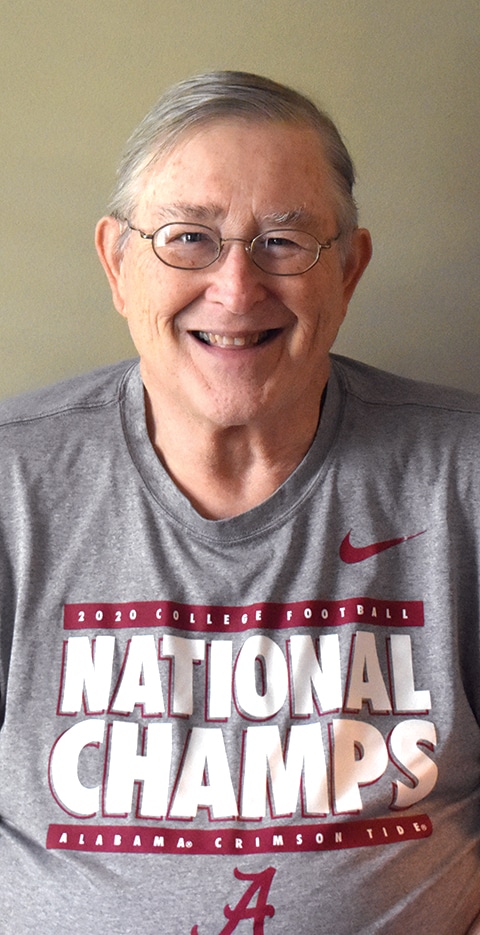The Vagabond recently received a message from Courtney Pinkard, who is the Reference Coordinator at the Alabama Department of Archives & History in Montgomery. She asked if I could send her photos or drawings of the first courthouse in Etowah County.
The Vagabond wrote an article about the old courthouse in the past, but many folks still want to know the history behind it. Many people have thought of remembering the old 1890 courthouse that existed through 1950. Little do they know!
Back when The Vagabond was attending high school, he was approached by the late Margaret Rouse, who was the former reference librarian at the Gadsden Pub-lic Library. She said that Etowah County tax assessor and historian Jerry Jones found the specifications of the old courthouse among old records.
Knowing that The Vagabond was a painter and a student of artist Margaret Hand, Ms. Rouse offered me a challenge to find those specifications, decipher the handwriting and paint an artist’s conception of what the courthouse probably looked like, since there was not a known picture of the structure at that time.
The project led to reading the handwriting from the 1890s specs, which was no easy task. There were many words that had to be deciphered and many words of architectural techniques to be looked up since they were no longer in use.
When the Alabama Legislature created Baine County in 1867, people who lived in portions of Cherokee, St. Clair, DeKalb, Blount and Marshall counties became citizens of a new county and were faced with setting up a county government. An election was held, and the county was soon in operation.
The question was, where would the offices of those elected officials be located at and where would court be held? The answer came when the old First Baptist Church located on the northwest corner of Fifth and Broad streets was offered for use until a courthouse could be built.
In the meantime, the name of the county was changed from Baine to Etowah. On Dec. 6, 1869, with James M. Moragne as Judge of Probate, a contract was let for the construction of a courthouse. Isaac P. Moragne was the contractor with the lowest bid in the amount of $12,990.
Completed in the spring of 1871, Etowah County’s first courthouse was a colonial brick structure of considerable beauty. The building was located between Broad, Locust, Court and Fourth streets, where the present Etowah County Board of Education is now located. There was a large porch in front that was supported by four huge white fluted columns on classic bases with classic caps. The large portico was located over the main entrance with an iron-railed veranda.
From the building’s balcony, bailiffs would call witnesses, jurors and litigants into court. The call of, “O yea, John Doe come into court,” could be heard around the town. That call summoned those who had business in court from checkers and chess games, drinking sessions in nearby saloons, horse trades, political discussions and loafing on places up and down Broad Street.
A bell was later placed in the squat tower to create attention for the summons. This small building was erected from bricks made by hand on the old James Gardner farm located at the present Gardner and 10th Street area. The building’s first floor was paved with well-burnt brick. However, the floor buckled several inches in many places and became ugly. The second floor was carpeted with cotton bagging, which was soon stained red from tobacco juice and became a collector of germs.
The courthouse yard was enclosed by a wooden fence with a front gate facing Broad Street. The yard was full of shade trees, mostly elms and a few nonbearing mulberry trees on the Fourth Street side. The plaza in front was made of poles and covered with hitching racks. At the foot of every post was a deep hole that had been pawed out of the earth by impatient mules and horses. Some of those holes eventually turned into hog wallows, so the area was not a pretty approach to the fine old building.
Many public meetings were held in the building, including strawberry and ice cream festivals. A well located on the Court Street that was roofed and enclosed with latticework side furnished water for all of the business houses and visitors.
In those days, the collection of streets of Gadsden to the west of the courthouse (now called Court Street) was called Lawyers’ Row, for obvious reasons. Court Street is the only street in town that that still has brick pavers. The warehouse buildings in the area have been preserved and feature nice shops. So much local history can be found in that small area!
The first courthouse building soon became too small to serve the needs of the county, and in 1890, the old building was taken down to make way for a larger building, which served the county until 1950. Before this building was constructed, a question came up of whether or not to locate the courthouse in Attalla. Two commissioners voted to move it to Attalla, while the other two commissioners voted to retain it in Gadsden. With a tie vote, it was necessary for Judge J.A. Tallman to cast the vote that would decide the location of the courthouse. His vote was to retain Gadsden as the county seat.
Contact The Vagabond at dkcrown@bellsouth.net.




